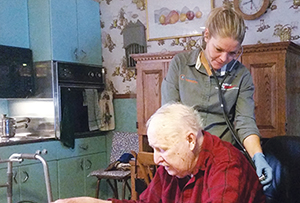Connie Dudzic of Lewiston, Maine, calls Daphne Russell her "genius angel."
Dudzic's husband, Lawrence, 84, suffers from diabetes, congestive heart failure and dementia. Russell, a community paramedic, visits the Dudzic home periodically to help the couple deal with Lawrence's complications.

The Dudzics used to be frequent callers to the Lewiston 911 dispatcher. There were ambulance runs and emergency room treatment, whenever Lawrence fell or experienced hypoglycemia. They haven't made an emergency call for more than a year. Connie Dudzic credits Russell's care and practical assistance. As a community paramedic, Russell provides care outside of a paramedic's customary emergency response role. She primarily focuses not on responding to health crises, but on working to prevent them in the first place. She'll rearrange furniture to lessen fall risks and advise them on snacks that can stabilize Lawrence's blood sugar when it starts to plummet.
Her employer, United Ambulance Service, is enrolled in one of 12 pilot projects for community paramedic programs in Maine. United Ambulance is owned jointly by St. Mary's Regional Medical Center and Central Maine Medical Center, the two hospitals in Lewiston, Maine's second largest city.
Hospital administrators are hopeful the expertise of community paramedics can improve disease management and the quality of life for people with chronic illnesses, while reducing the costs of repeat emergency visits and admissions. So far, they say, it has reduced by half the emergency care for participating patients.
Respect the uniform
Connie Dudzic values Russell's advice and assistance.

"He gets along fairly well, but most of the time he'd just rather sit or be in bed," Connie Dudzic said of her husband. "He can be stubborn. Daphne is very kind and capable. She also is persistent. I know she can handle an emergency without panicking."
Many of the patients' challenges, from slippery throw rugs to inappropriate use of medicine, are shortcomings that paramedics see every day but can't deal with in the grip of an emergency. The community paramedic program gives the paramedics time and license to do this type of practical risk assessment and prevent potential injury.
Russell arrives at the Dudzics' home wearing her United Ambulance uniform, and she carries a standard paramedic bag. She drives an ambulance service SUV. Her profession gives her credibility: Chronically ill people, who regard ambulance crews as lifesavers, may be more apt to heed a community paramedic's suggestions.
"Many of these patients have a natural trust in the paramedics," said Susan Keiler, chief operating officer at St. Mary's Regional Medical Center.
Safe at home
Russell has been one of two community paramedics for United Ambulance since 2013. Those positions were created after the state of Maine adopted a program to test the concept. Similar pilots or programs are underway in Colorado, Minnesota, North Carolina and Texas, according to the California Emergency Medical Services Authority, a state agency that is testing the use of community paramedics in that state.
Keiler said the program allows the local health system to monitor the progress of patients who no longer qualify for in-home health services, and to provide them with care that can prevent relapses.
"This can minimize readmissions," Keiler said. "But at a higher purpose, this can help to ensure that a patient is eased back into the highest level of functioning possible. It provides continuity for patients so they can be safe in their homes."
Patients are referred to the program by their primary doctors or a hospital. For the most part, the patients live alone or have limited assistance at home. Community paramedic visits include routine health checkups, with glucose tests and administration of vaccines, as well as monitoring patient adherence to prescriptions and care routines.
The value proposition
Keiler, who serves on the United Ambulance board of directors, said, for now, Maine doesn't provide public reimbursement for the program, but the participating hospitals are hoping to persuade state legislators to make it eligible for reimbursement, as it is in Minnesota. The ambulance service covers the cost for the community paramedic program.
Russell, a paramedic since 2003, said she took 400 hours of classroom and clinical study in the paramedic program offered through Colorado Mountain College in Glenwood Springs, Colo. She learned about management of chronic illnesses and medications, advanced treatment of wounds and methods for assessing and improving home environments. "All of these are things that paramedics see on a regular basis," Russell said. "If someone takes a fall and returns to the same environment, it's likely to happen again. My work might be as simple as helping someone get a shower chair, or a raised toilet seat. I see people who have trouble managing their medications."
United Ambulance employs 120 full- and part-time paramedics and emergency medical technicians and, on an average shift, runs seven ambulances that serve the greater Lewiston area of about 60,000 people. She and the other community paramedic, who works part-time for the program, also assist in emergency calls as needed. Russell said they make about 70 home visits each month, and get five to eight new referrals monthly as well. She said they have served more than 200 patients since 2013.
Statewide, the 12 ambulance services that employ community paramedics made nearly 2,000 home visits during the fiscal year that ended July 1, nearly triple the visits undertaken the year before.
The state pilot program runs through this summer. Keiler said St. Mary's has been pleased with the results and plans to continue the service. The effort advances St. Mary's mission "of serving people on the margin." For United Ambulance, she said, it is a way to broaden its participation in health care services.
"It has exceeded our expectations," she said. "We in health care are trying to get better at managing needs and predicting what patients might need in the future. Community paramedics are a very value-added extension of that care."
